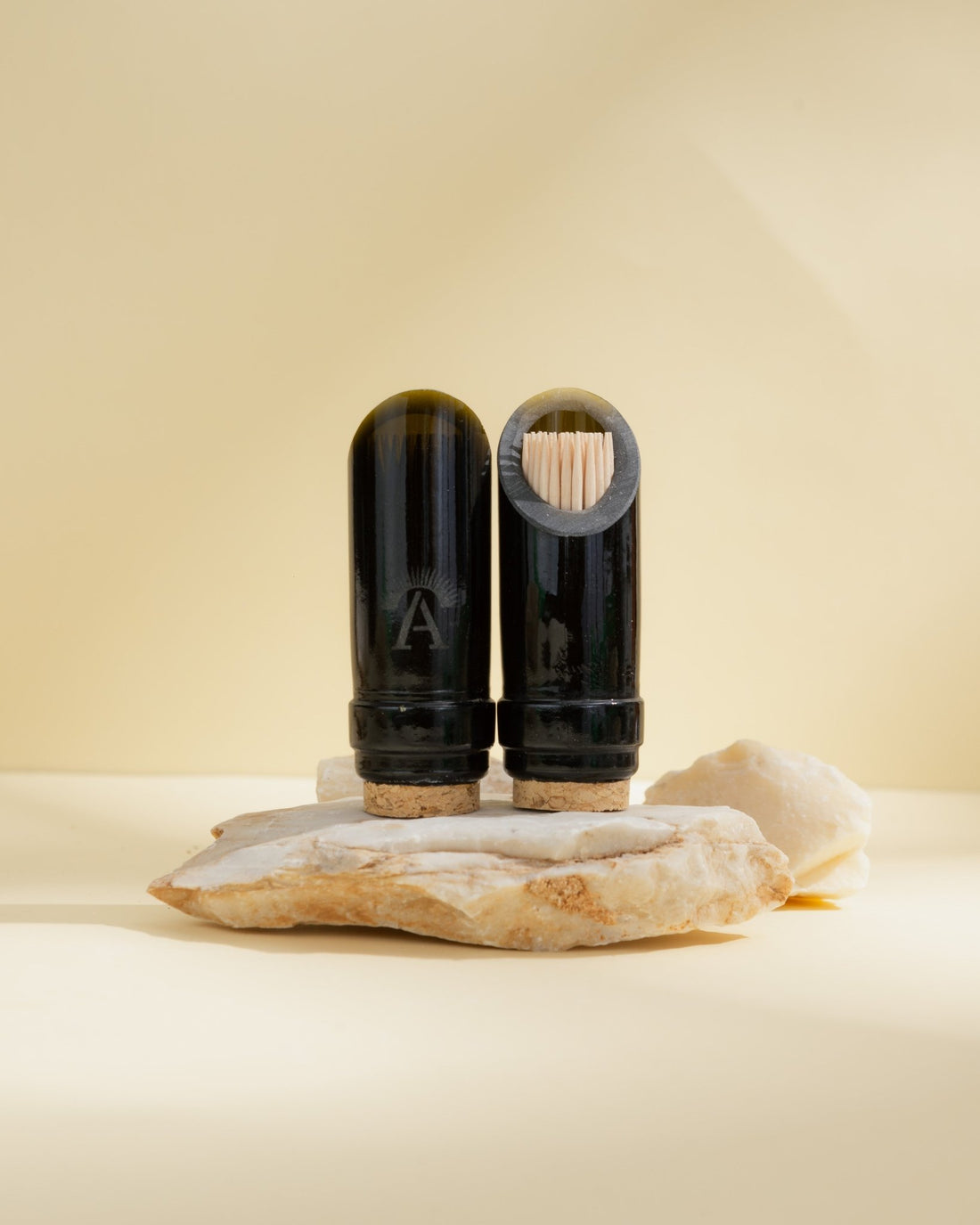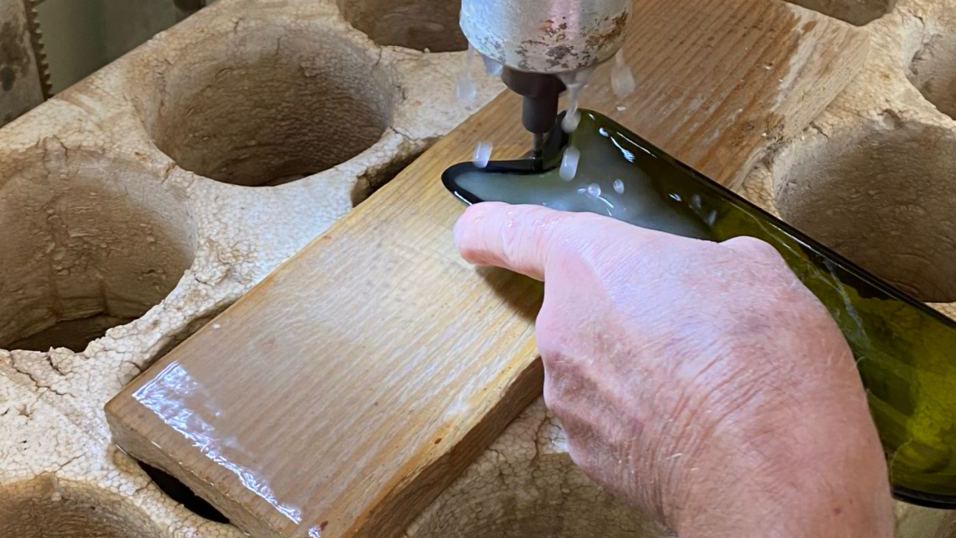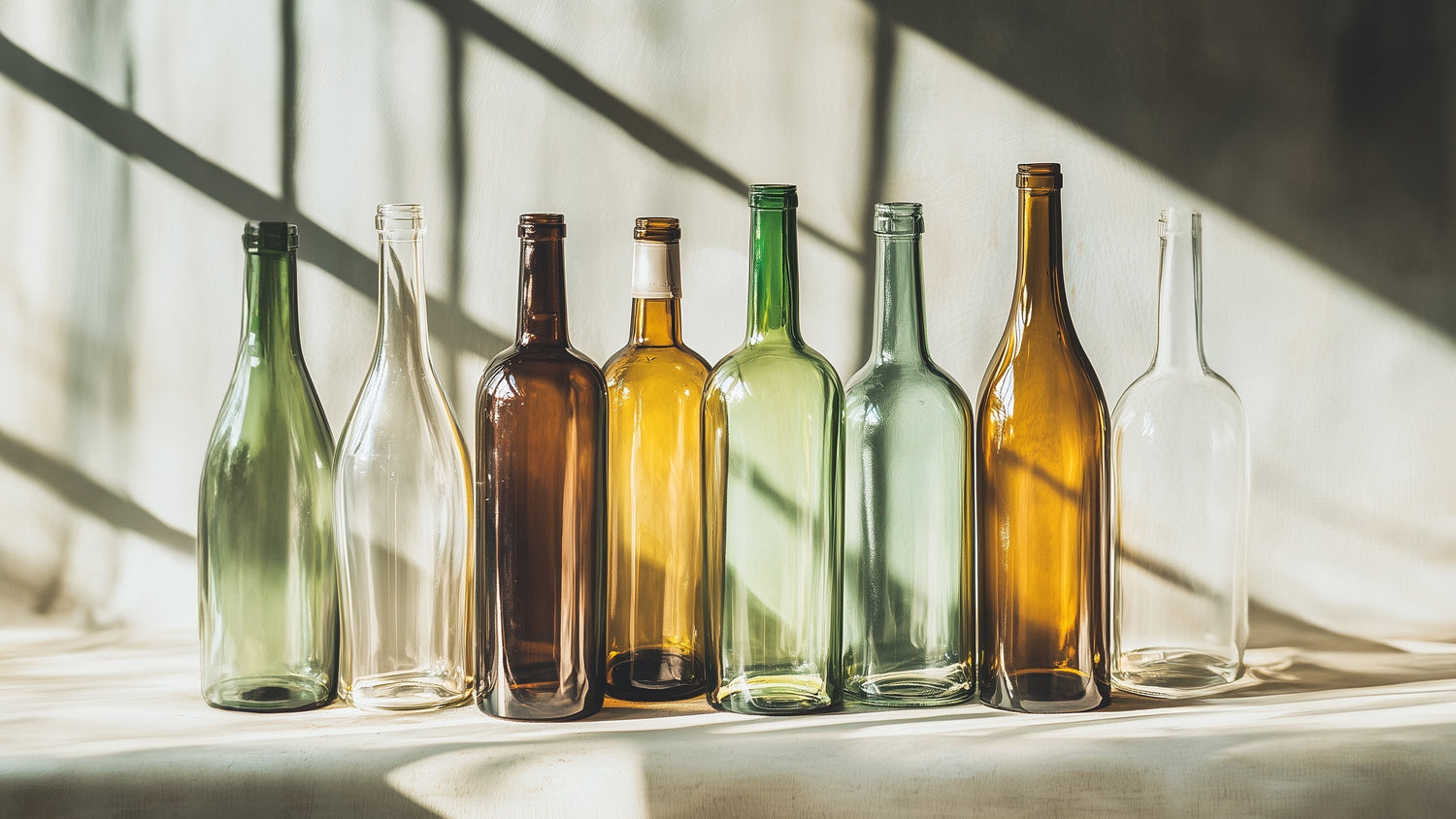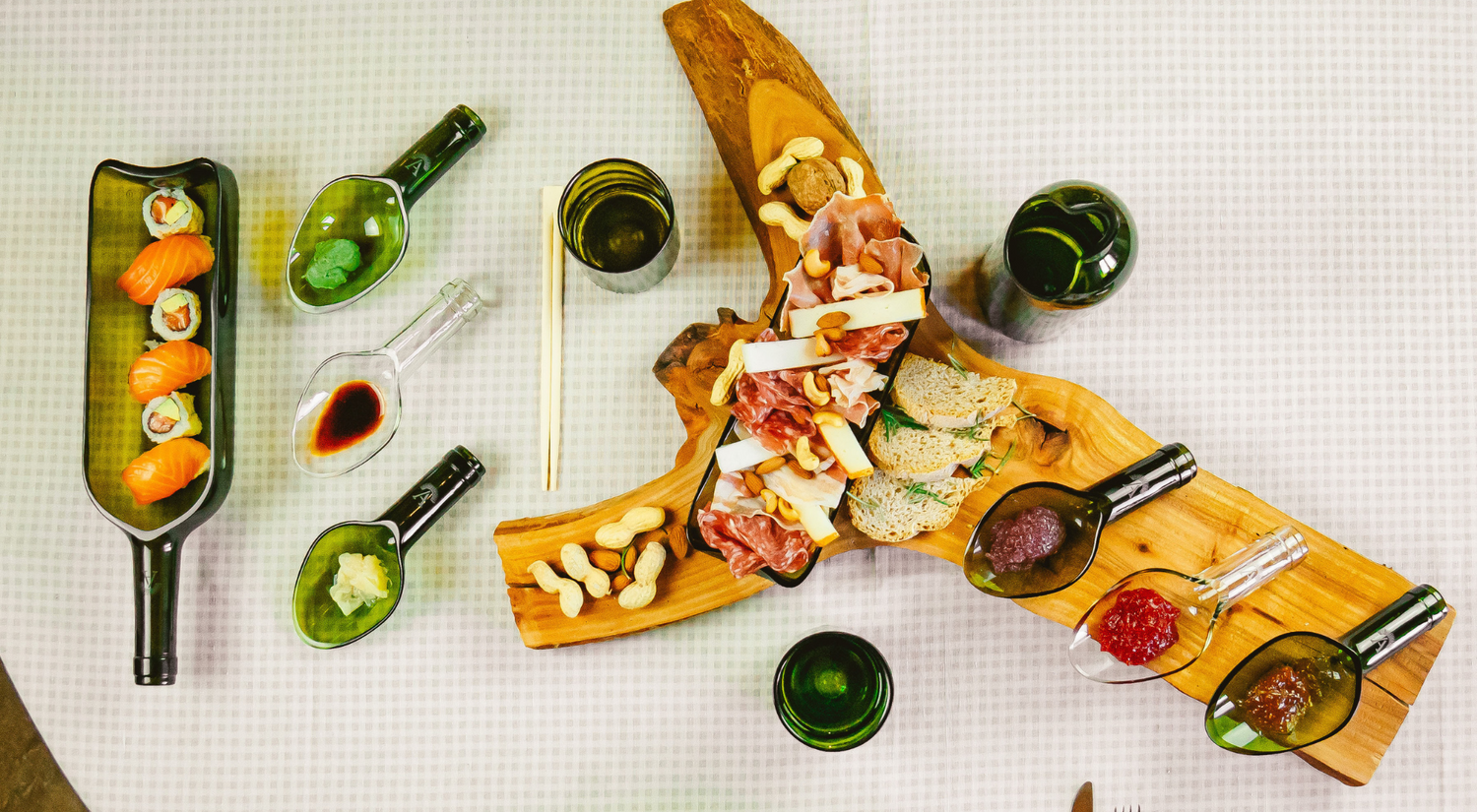Have you ever watched an elegant goblet reflect light with that almost magical brilliance and wondered what makes it so special?
The answer lies in a fundamental chemical difference that transforms a simple vitreous material into what we call crystal.
This isn't just a matter of aesthetics: behind that luster lie centuries of artisanal tradition, precise regulations, and unique physical properties that are worth understanding to make informed choices.
In this guide, you'll discover how to confidently distinguish glass from crystal, understand their distinctive characteristics, and appreciate the traditions that make them protagonists of our tables.
The chemistry behind brilliance: why crystal shines brighter
The fundamental difference between glass and crystal is not visible to the naked eye but lies in their molecular composition.
Traditional glass, technically known as soda-lime glass, is created by melting silicon oxide (representing 60-70% of the total), soda (12-18%), and lime (5-12%).
This combination creates a homogeneous material with a random molecular structure, similar to liquids but solidified.
Crystal, on the other hand, is distinguished by the addition of a special component: lead oxide.
For glass to be legally defined as crystal, it must contain at least 24% lead oxide by weight.
This threshold is not arbitrary but established by European regulation CEE 69/493, which protects consumers from misleading definitions.
How lead oxide transforms the material
The introduction of lead oxide into the vitreous mixture triggers an extraordinary transformation.
Lead dramatically increases the density of the material and, consequently, its refractive index.
This phenomenon causes light to pass through crystal behaving similarly to what happens in diamond: it's refracted with greater intensity, creating that effect of brilliance and luster that characterizes authentic crystal.
The higher the percentage of lead oxide, the more evident this optical effect becomes.
However, excessively high concentrations would give the material an unwanted yellowish coloration.
This is where the mastery of specialized chemists comes into play, working alongside expert master glassmakers to perfectly calibrate the formula to obtain transparent, brilliant, and stable crystal.
Recognizing crystal: practical tests that never fail
Distinguishing crystal from common glass may seem complex, but there are reliable empirical methods you can easily apply.
The sound test: when material "sings"
One of the most immediate methods to recognize crystal is the sound test.
Gently tap the edge of the object with your fingernail or a light utensil: crystal will produce a clear, prolonged, almost musical sound.
This characteristic sonority derives from the presence of lead oxide, which gives the material unique acoustic properties thanks to its greater elasticity.
Common glass, in contrast, emits a dull, brief sound lacking resonance.
It's like the difference between ringing a bronze bell and tapping on a piece of rigid plastic.
The weight test: density doesn't lie
The superior density of crystal makes it immediately recognizable to touch.
A crystal object will weigh noticeably more than an equivalent glass item of the same dimensions.
This difference is due to the atomic mass of lead, which is much higher than that of elements composing traditional glass.
Try holding an Amarzo glass from the colorful collection: despite being made of high-quality recycled glass, the weight will be perceptibly lower than a crystal goblet of similar dimensions.
The optical test: brilliance and refraction compared
The refractive index of crystal is significantly higher than that of common glass.
Observe how light passes through the object: crystal will create more vivid and defined reflections, decomposing light more evidently.
Looking through crystal, objects will appear slightly magnified and contours will be sharper thanks to the greater refraction capacity.
Territorial excellence: Colle Val d'Elsa and Tuscan glassmaking tradition
Speaking of glass and crystal processing in Italy inevitably means looking toward Tuscany, and particularly toward Colle Val d'Elsa.
This fascinating medieval town is nicknamed "Italy's Bohemia" for its extraordinary glassmaking tradition.
The numbers speak clearly: Colle Val d'Elsa produces 95% of Italian crystal and a remarkable 14% of world production, making it an internationally recognized center of excellence.
Historical roots of a millennial art
The glassmaking vocation of this territory has roots in the Middle Ages, when the area could count on ideal natural resources.
High-quality silica sand, quartzite, sodium carbonate, magnesium, abundant waterways, and forests providing necessary fuel: all elements that favored the development of this artisanal activity.
The real quality leap occurred in 1800, when Francesco Mathis built the first factory specialized in crystal production, originating an industrial tradition that continues today.
Innovation in continuity: cold grinding
The Tuscan glassmaking tradition hasn't remained crystallized in the past but has evolved by integrating innovative techniques.
A significant example is represented by Amarzo company, which operates in the heart of Colle Val d'Elsa developing the cold grinding technique.
This revolutionary process allows glass processing without using heat, completely preserving the original properties of materials and guaranteeing superior precision finishing.
Cold grinding, applied mainly to recycled glass, maintains the intact molecular structure of the material while drastically reducing energy consumption and environmental impact.
Types of glass: a universe of possibilities beyond crystal
The glass-making world is much more varied than one might imagine, with different categories serving specific applications.
Soda-lime glass: the everyday protagonist
Soda-lime glass represents the most widespread and accessible type.
Its balanced composition of silica (60-70%), soda (12-18%), and lime (5-12%) makes it versatile and suitable for most domestic uses.
While not reaching crystal's brilliance, it offers excellent characteristics of resistance and durability.
Amarzo products made with 100% recycled glass perfectly demonstrate how this material can be transformed into refined design objects.
Their pitchers with oblique cutting and anti-drip shape represent an example of how functionality and aesthetics can coexist harmoniously in traditional glass.
Borosilicate glass: resistance to extreme temperatures
Borosilicate glass contains at least 5% boric anhydride, a characteristic that makes it extremely resistant to thermal shock and chemical corrosion.
This type is used mainly for laboratory glassware, oven-safe containers, and double-wall glasses with thermal insulation properties.
The double wall of borosilicate glasses allows long retention of both heat and cold temperatures, making them ideal for hot or cold beverages.
Tempered glass: safety and resistance
Tempered glass undergoes a "tempering" process that modifies its internal structure, increasing its resistance.
This controlled thermal treatment makes the material 4 to 6 times more resistant than normal glass.
In case of breakage, tempered glass shatters into small blunt pieces, significantly reducing the risk of serious injury.
Edge processing: the detail that makes the difference
An often overlooked but fundamental aspect in distinguishing between glass and crystal objects concerns edge processing.
Hot cut edge: practicality and robustness
The hot cut edge typically characterizes common glass tumblers.
This type of finish presents a relatively thick edge that appears slightly raised compared to the glass body.
During production, the protruding edge is cut while the glass is still hot and subsequently polished.
Glasses with hot cut edges generally have thick walls and a robust structure, ideal for daily use.
Cold cut edge: elegance and refinement
The cold cut edge is a distinctive feature of high-quality crystalline glass tumblers.
This type of processing produces an extremely fine and delicate edge, much more elegant and pleasant in contact with lips.
The process involves cutting and polishing via laser, guaranteeing millimetric precision.
Glasses with cold cut edges usually present thin walls and are intended for serving precious beverages or formal occasions.
Sustainability and circular economy: the future is in glass
One of the most significant differences between glass and crystal concerns their environmental impact and recycling possibilities.
Glass: a champion of sustainability
Glass represents one of the most sustainable materials in absolute terms, being able to be recycled infinitely without losing quality or properties.
This intrinsic characteristic makes it a protagonist of the circular economy.
Amarzo company perfectly embodies this philosophy, transforming exhausted wine bottles into elegant design objects through zero-emission processes.
Their trays obtained from longitudinal cutting of bottles, available in "with neck" and "without neck" variants, show how materials destined for the bin can be reborn as refined furnishing complements.
The "Lux" lamps represent another virtuous example: from a simple bottle emerges an art object that combines lighting and sustainability.
Crystal: complexity in recycling
Lead crystal presents greater criticalities from a recycling perspective.
The presence of heavy metals requires specific disposal processes and doesn't allow conferral together with common glass in normal separate collections.
This characteristic makes crystal less compatible with circular economy principles, despite its undeniable beauty and elegance.
Certifications and regulations: protecting consumers from imitations
Given the difficulty in visually distinguishing glass and crystal, specific regulations exist to protect consumers.
European regulation CEE 69/493
All European Union countries have adopted regulation CEE 69/493, which establishes precise criteria for classification and labeling of different glass types.
The parameters considered are:
- Exact chemical composition
- Scientifically measured refractive index
- Precisely determined specific weight
Beware of misleading definitions
In the market, it's frequent to encounter terms like "crystalline" or "sound glass", which can confuse consumers.
These definitions indicate products made with glass containing less than 24% lead oxide, therefore not qualifiable as true crystal according to European regulations.
Only products explicitly bearing the certification "crystal with 24% lead" can be considered authentic crystals.
The art of grinding: tradition and innovation compared
Grinding represents one of the most delicate and artistic phases in glass and crystal processing.
Traditional techniques for crystal
Crystal grinding requires particular attention and specialized competence.
The greater material hardness due to lead presence necessitates more resistant equipment and specific abrasives.
The wheels used for crystal are finer and made with superior quality abrasive materials, often diamond-tipped.
The traditional process involves controlled temperatures and longer processing times to obtain perfect finishes.
Sustainable innovation in glass grinding
The cold grinding developed by companies like Amarzo represents a significant evolution in processing techniques.
This innovative process uses exclusively water and diamond wheels, avoiding the use of high temperatures.
The result is a processing that completely preserves recycled glass characteristics, guaranteeing precision finishes with tolerances of ±1 mm.
Surfaces are polished with grits ranging from 600 to 800, ensuring smooth and uniform finishing.
Practical applications: when to choose glass or crystal
The choice between glass and crystal must consider various practical and aesthetic factors.
Glass for daily use
Common glass proves ideal for daily use thanks to various characteristics:
- Accessible cost making it suitable for large quantities
- Superior resistance to accidental impacts
- Ease of maintenance with possibility of dishwasher washing
- Versatility in shapes and applications
Amarzo colorful glasses from the "Primitivo" (bright green), "Barbera" (ivory black), and "Malvasia" (pastel yellow) collections demonstrate how recycled glass can offer elegance and personality without sacrificing practicality.
The coffee cups in recycled glass of 50-70ml represent an example of how functionality and sustainability can coexist perfectly in daily use.
Crystal for special occasions
Crystal excels in contexts requiring maximum elegance:
- Absolute transparency that enhances beverage color and consistency
- Distinctive sonority adding a sensory element to the experience
- Incomparable brilliance for extraordinary visual impact
- Symbolic value and recognized prestige
Crystal goblets with their thin walls and superior stability are irreplaceable for prestigious wine tastings or important celebrations.
Art objects and design: the versatility of recycled glass
Recycled glass is conquering the design world thanks to its versatility and the added value of sustainability.
Sustainable lighting
Amarzo lamps created from recycled bottles represent a perfect balance between functionality and environmental respect.
Each lamp is a unique piece that tells the story of the original bottle, transforming waste into an illuminating art object.
The warm light filtering through colored glass creates cozy and sophisticated atmospheres.
Innovative furnishing complements
The Fenestra, decorative bottle available in Classic (0.75L), Magnum (1.5L), and Jèrobam (3L) formats, demonstrates how glass can become sculpture.
The central empty space creates light and shadow games that enhance any environment.
The trays in different variants (Barbera with neck, half neck, sparkling wine with neck, Barbera without neck) unite functionality and design, adapting to different uses: from table service to furnishing as empty pockets or jewelry holders.
Table accessories: when details make the difference
Minor accessories often reveal care and attention to quality.
Spoons and glass cutlery
The cocktail spoons obtained from bottle necks represent an example of creativity applied to reuse.
These small utensils, available in the same colors as main collections, are perfect for finger food and sophisticated aperitifs.
Cutlery rests and refined details
Amarzo cutlery rests, always made from recycled bottle necks, add a touch of class to table setting.
The possibility of customization through laser engraving allows adaptation to any context, from gourmet restaurants to domestic tables.
Conservation and care: tips to maintain beauty over time
Proper maintenance ensures longevity and beauty for both glass and crystal.
Daily glass care
Common glass tolerates frequent washing well and can be placed in dishwashers without particular precautions.
For delicate objects like Amarzo cups, using microfiber cloths is recommended to avoid micro-scratches on the surface.
Cleaning with circular movements and non-aggressive detergents maintains original brilliance.
Crystal maintenance
Crystal requires greater attention to preserve its unique characteristics.
Hand washing is preferable to avoid impacts that could cause chipping or breakage.
To enhance natural brilliance, solutions of lukewarm water and vinegar or water and denatured alcohol can be used, always followed by drying with soft cloths.
Investment and value: long-term economic considerations
The choice between glass and crystal can also be evaluated from an economic perspective.
Crystal tends to maintain or increase its value over time, especially if coming from renowned manufacturers or featuring particular workmanship.
Glass, while having a lower initial value, can acquire importance if representing examples of significant design or testimonies of local artisanal traditions, like products from Tuscan glassworks.
Future perspectives: innovation and tradition
The future of glass processing seems increasingly oriented toward sustainability and circular economy.
The goal of using 100% recycled glass to reduce environmental impact and production costs is becoming reality thanks to innovative realities like Amarzo.
The combination between traditional techniques of the Tuscan school and innovative processes with low environmental impact opens interesting scenarios for the sector.
The conscious choice: glass or crystal?
Choosing between glass and crystal means balancing different priorities: functionality, aesthetics, sustainability, and budget.
If you prioritize daily use and environmental responsibility, quality recycled glass represents an excellent choice.
Amarzo products demonstrate how it's possible to unite design, functionality, and environmental respect without compromising on quality.
If instead the goal is achieving maximum elegance for special occasions, crystal with its 24% lead oxide offers an incomparable sensory experience.
The glassmaking tradition of Colle Val d'Elsa continues to represent a world reference point, demonstrating that innovation and tradition can coexist harmoniously.
Now you possess all the necessary knowledge to recognize, appreciate, and consciously choose between these two extraordinary materials that enrich our homes with beauty and functionality.


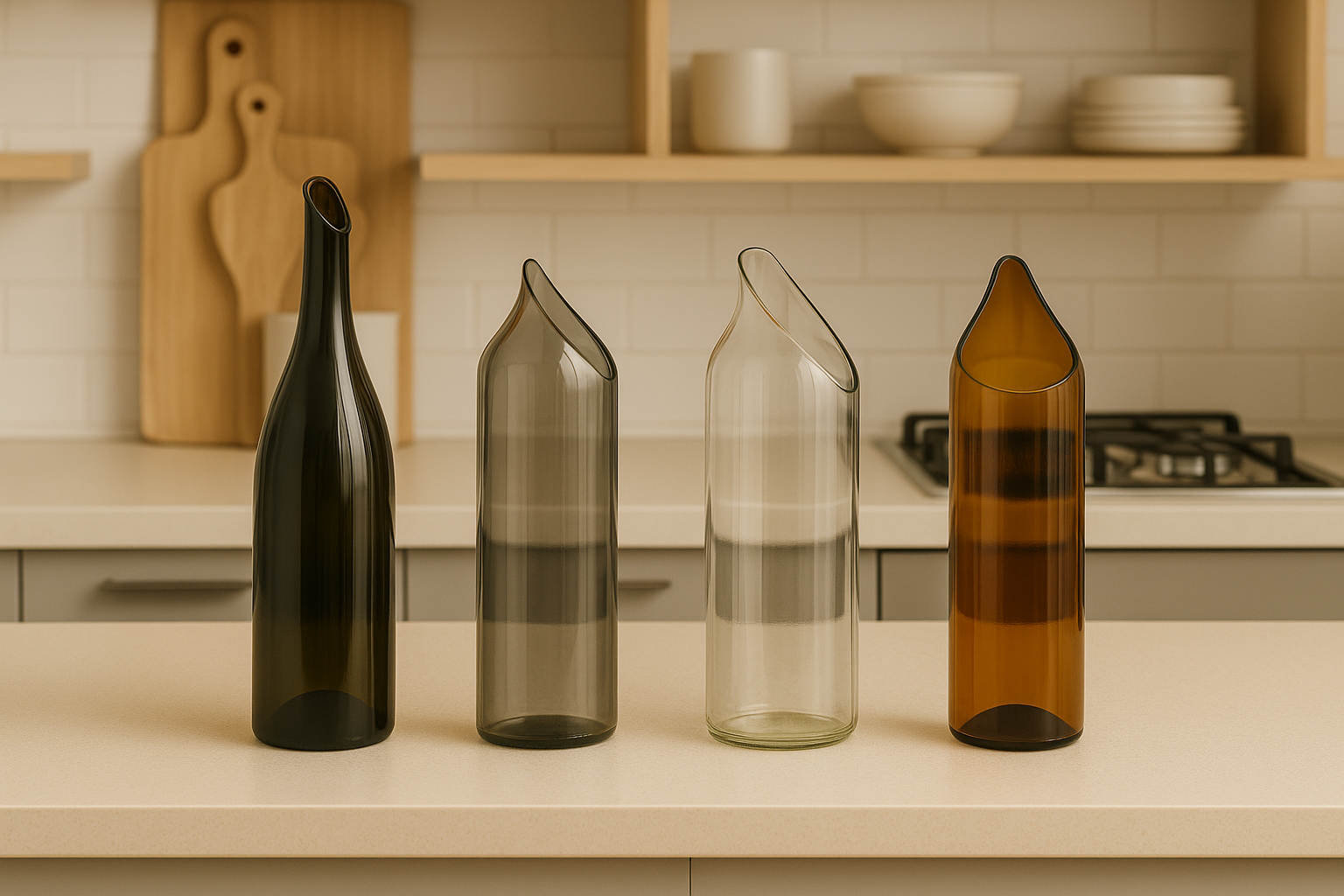
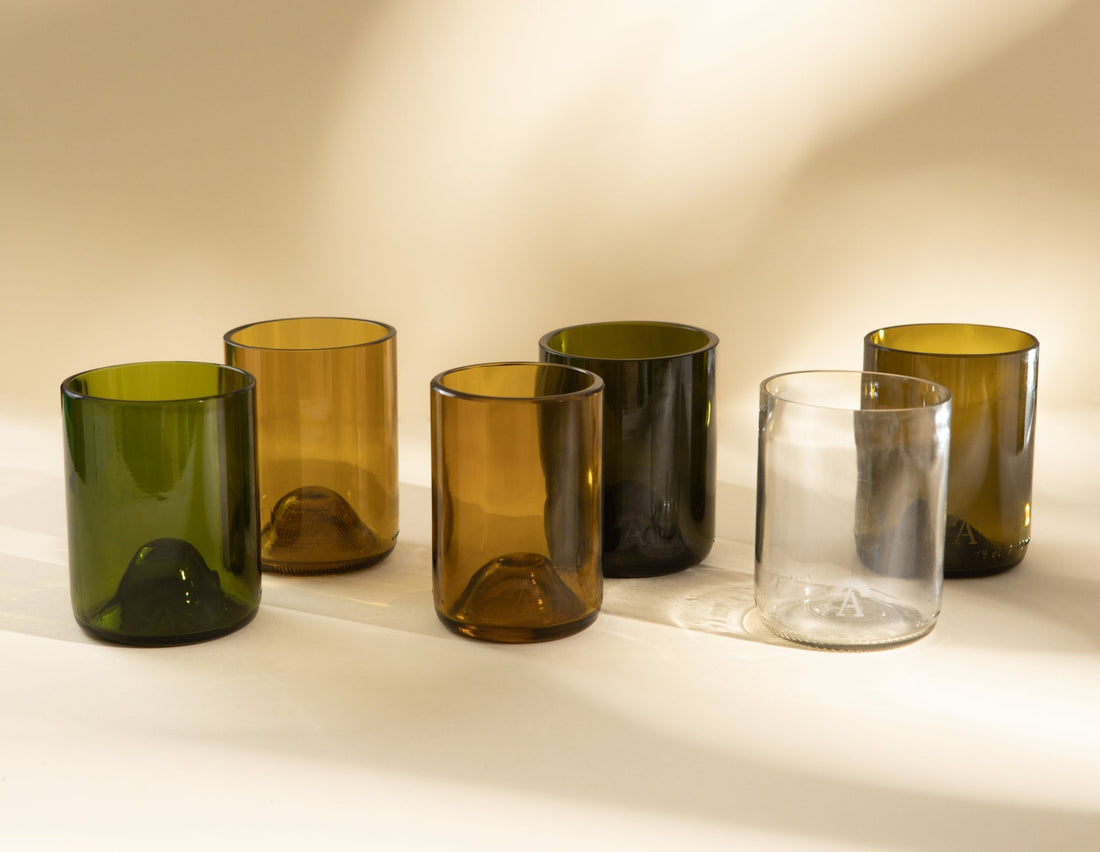
![Vassoio con Collo di Vetro Riciclato [Lav. Lucida]](http://amarzo.com/cdn/shop/products/vassoio-con-collo-125288.jpg?v=1699712421&width=1100)

